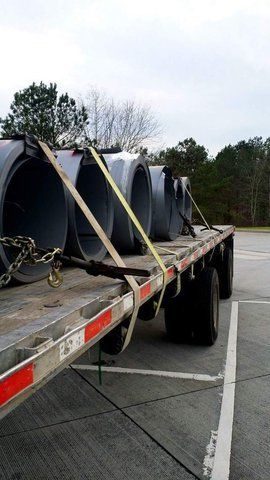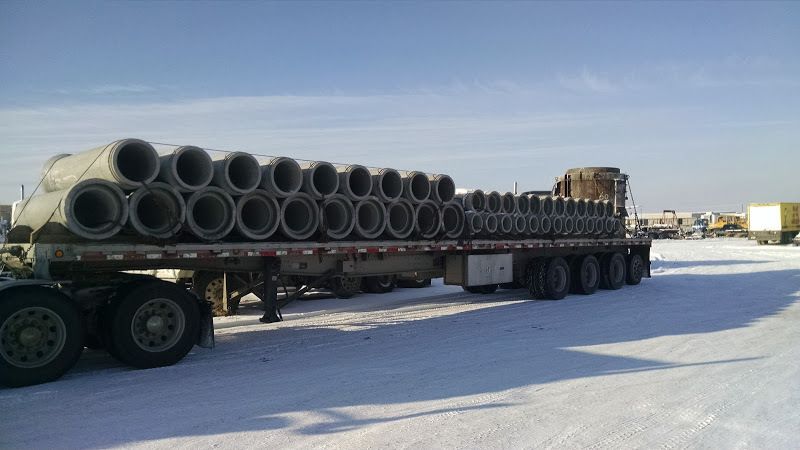Thoughts On This Load
Topic 12319 | Page 2
I wouldn't take this load more than two miles or at any speed above 15 mph. Here's why I would never haul them this way, and why I would do my best to get a lot of distance between me and this trailer if I saw it on the road:
1. There's not nearly enough securement there to keep the coils from rolling forward on a hard brake, or even from rolling backward if the truck hits something hard and bounces back. The requirement is 80% of the weight secured from forward motion, 50% of the weight for side to side and upward motion, and 20% for rearward motion. I count 6 coils that weigh at least 4,000 pounds each. (Maybe more.) That's at least 24,000 pounds. 80% of that is 19,200 pounds. The one chain pulling backward is worth 4,700 pounds at best.
From what I can see, there's only one chain securing from forward motion and one securing from rearward motion. The straps all put downward pressure, but coils roll.
If they start rolling or sliding, those straps aren't going to help at all. The only friction between the coils and the deck is the tiny area where the curved surface of the coil touches it, instead of all the area against the deck using coil racks. (Well, ok, you can see at least one coil is sort of flattened on the deck.)
Those edge protectors should keep the straps from cutting, and they're rated for 700 pounds more than 5/16 chain. If the edge protector cracks, though, the strap could be cut, and again, the only securement they provide against forward motion is whatever friction there is between the coil and the deck. If the coils slide enough to get out from under the downward pressure applied by the straps over the top, they'll start rolling since there are no coil racks.
Which leads me to
2. No coil racks with boards under any of the coils in the picture. On slinky coils, you only put coil racks under the front and rear coils and they're loaded squished together, but individual coils like this each need coil racks to keep them from rolling.
3. They're all touching the deck. Now, if the receiver doesn't care that their steel gets bent up as it bounces down the road, maybe that's fine, but I would never do it. If the coil is too small for the coil rack, you can put blocks in between the boards and the coil racks, and/or put two thick rubber strips over the boards and under the coils so the coil never hits the deck. It's hard on the deck as well.
4. This guy hooked at least two of his ratchets to the rub rail or maybe to the stake pocket instead of wrapping the chain around a spool, hooking the chain to itself, and then hooking the ratchet to the chain links to take out the slack. It might be technically legal to do it this way, I don't know, but even if it is, it's still sloppy, stupid, and lazy, since it fails to maximize the amount of securement, and it doesn't take more than an extra 15 seconds per ratchet to do it right.
By the way, I've heard a lot of guys say, "I haul 'em this way all the time and never had a problem." I've even seen guys secure coils almost as poorly as this. The question you need to ask is, have any of those times included an event where you had to slam on the brakes or take evasive action or got hit head on by someone who jumped the median? Securement isn't about the 99.99% of the time that the trip is uneventful. It's about the 0.01% of the time when something goes wrong.
The longer you do it the wrong way, the harder it is to change and the more likely it is that you'll have one of those events. Hopefully this driver doesn't die or kill someone else because of one of those rare events. Otherwise, it will be just one more case illustrating why they're called "suicide coils" when they're loaded in this way.
HOS:
Hours Of Service
HOS refers to the logbook hours of service regulations.
1. There's not nearly enough securement there to keep the coils from rolling forward on a hard brake, or even from rolling backward if the truck hits something hard and bounces back. The requirement is 80% of the weight secured from forward motion, 50% of the weight for side to side and upward motion, and 20% for rearward motion. I count 6 coils that weigh at least 4,000 pounds each. (Maybe more.) That's at least 24,000 pounds. 80% of that is 19,200 pounds. The one chain pulling backward is worth 4,700 pounds at best.
Bud, the rule is .8Gs of force not 80% of the weight. Don't worry about it, this misinformation is spread all over the place. There is a way to figure it with a math equation but I can't remember it. So with that even the chains that are pulling down contribute with the friction created to help meet the .8Gs of force.
For example, using your formula, for a 50k coil you would need 9 chains pulling back and three pulling forward. I don't know about you but most people do not even carry that many chains. Personally, I carry 14 each 3/8" chains and 12 each 1/2" chains.
4. This guy hooked at least two of his ratchets to the rub rail or maybe to the stake pocket instead of wrapping the chain around a spool, hooking the chain to itself, and then hooking the ratchet to the chain links to take out the slack. It might be technically legal to do it this way, I don't know, but even if it is, it's still sloppy, stupid, and lazy, since it fails to maximize the amount of securement, and it doesn't take more than an extra 15 seconds per ratchet to do it right.
This is obviously a chaparral trailer based on the rub rail construction. It has no chain spools at all. You can see what is there just in front of the ratchet binder between the stake pockets. Basically a 6" flat on top and 2" angled down at 45° on both ends. That is all fine and good but if you have seen some of their trailers or used one, you know that that particular piece of aluminum tears easily. Not the welds but through the center of the piece. It is really a poor design.
As for the lack of coil racks etc, we can not see if he built a bulk head in the front of the trailer or if he used 4x6 wedges in the front or the rear. Take a look at the front of my photo and you will see 4x6 wedges in front of the lower pipe. Doesn't look secure but it is and it is legal.

I have my doubts on the legality of the load, but for me I wouldn't haul this load secured like that. I would like to see the first and last coil to see how they are secured and if they have coil racks. I certainly would not run my straps over the top like that, but would run them through the eye and inside the rub rail as you easily can on this load. The outside the rub rail tolerance for DOT is when you can't get the strap through for maybe a load of plates that are rub rail to rub rail or over (there are other examples, that's not exclusive). I absolutely would not have my strap rubbing my binder like that, its's a good way to ruin a strap. The coils look thin so the securement to weight is probably OK, but keep in mind if he is using a steak pocket, they are rated at a lower weight than the "spools". It doesn't matter if you have a 7,000 LBS chain if you are using a 2,500 LBS steak pocket on each side your securement rating is only 5,000 LBS. All though this manufacturer does not have traditional round spools, they do have spools to utilize. I'm also surprised the receiver doesn't mind the coils sitting on the deck like that.
DOT:
Department Of Transportation
A department of the federal executive branch responsible for the national highways and for railroad and airline safety. It also manages Amtrak, the national railroad system, and the Coast Guard.
State and Federal DOT Officers are responsible for commercial vehicle enforcement. "The truck police" you could call them.
1. There's not nearly enough securement there to keep the coils from rolling forward on a hard brake, or even from rolling backward if the truck hits something hard and bounces back. The requirement is 80% of the weight secured from forward motion, 50% of the weight for side to side and upward motion, and 20% for rearward motion. I count 6 coils that weigh at least 4,000 pounds each. (Maybe more.) That's at least 24,000 pounds. 80% of that is 19,200 pounds. The one chain pulling backward is worth 4,700 pounds at best.
Bud, the rule is .8Gs of force not 80% of the weight. Don't worry about it, this misinformation is spread all over the place. There is a way to figure it with a math equation but I can't remember it. So with that even the chains that are pulling down contribute with the friction created to help meet the .8Gs of force.
For example, using your formula, for a 50k coil you would need 9 chains pulling back and three pulling forward. I don't know about you but most people do not even carry that many chains. Personally, I carry 14 each 3/8" chains and 12 each 1/2" chains.
4. This guy hooked at least two of his ratchets to the rub rail or maybe to the stake pocket instead of wrapping the chain around a spool, hooking the chain to itself, and then hooking the ratchet to the chain links to take out the slack. It might be technically legal to do it this way, I don't know, but even if it is, it's still sloppy, stupid, and lazy, since it fails to maximize the amount of securement, and it doesn't take more than an extra 15 seconds per ratchet to do it right.
This is obviously a chaparral trailer based on the rub rail construction. It has no chain spools at all. You can see what is there just in front of the ratchet binder between the stake pockets. Basically a 6" flat on top and 2" angled down at 45° on both ends. That is all fine and good but if you have seen some of their trailers or used one, you know that that particular piece of aluminum tears easily. Not the welds but through the center of the piece. It is really a poor design.
As for the lack of coil racks etc, we can not see if he built a bulk head in the front of the trailer or if he used 4x6 wedges in the front or the rear. Take a look at the front of my photo and you will see 4x6 wedges in front of the lower pipe. Doesn't look secure but it is and it is legal.
Thanks, Pat, I didn't know about chaparral trailers. I just get creeped out when I see a chain hook swinging loose like that.
And yes, the .8g explanation isn't exactly accurate, but it is the way most drivers talk about it, whether they understand the difference or not. I haven't done any trigonometry for 30 years at least, but I do know that steel on aluminum must have a lower coefficient of friction than wood on aluminum, so I'm still not convinced that the downward pressure from the straps would be enough to give him the .8g he needs for forward motion.
And this load is different from your pipes. I'm sure you have cable running front to back on those pipes to help unitize them, and chains putting the force in the correct direction on the front and rear. These coils look like they are touching, but I wonder if there's sufficient securement to say they're unitized. I'd be worried about one of them starting to wobble back and forth independently of the others.
I too would like to see the front and rear of the load to see how it's secured. Wedges or another coil we can't see in a cradle or coil rack would make me feel better about it.
Anyway, it's a whole lot more fun to criticize someone else's load than to have mine picked apart. So far, so good!

HOS:
Hours Of Service
HOS refers to the logbook hours of service regulations.OOS:
When a violation by either a driver or company is confirmed, an out-of-service order removes either the driver or the vehicle from the roadway until the violation is corrected.

I have my doubts on the legality of the load, but for me I wouldn't haul this load secured like that. I would like to see the first and last coil to see how they are secured and if they have coil racks. I certainly would not run my straps over the top like that, but would run them through the eye and inside the rub rail as you easily can on this load. The outside the rub rail tolerance for DOT is when you can't get the strap through for maybe a load of plates that are rub rail to rub rail or over (there are other examples, that's not exclusive). I absolutely would not have my strap rubbing my binder like that, its's a good way to ruin a strap. The coils look thin so the securement to weight is probably OK, but keep in mind if he is using a steak pocket, they are rated at a lower weight than the "spools". It doesn't matter if you have a 7,000 LBS chain if you are using a 2,500 LBS steak pocket on each side your securement rating is only 5,000 LBS. All though this manufacturer does not have traditional round spools, they do have spools to utilize. I'm also surprised the receiver doesn't mind the coils sitting on the deck like that.
Mmmmmmmmm, steak pockets... I could use some of those!
DOT:
Department Of Transportation
A department of the federal executive branch responsible for the national highways and for railroad and airline safety. It also manages Amtrak, the national railroad system, and the Coast Guard.
State and Federal DOT Officers are responsible for commercial vehicle enforcement. "The truck police" you could call them.
HOS:
Hours Of Service
HOS refers to the logbook hours of service regulations.
It's all good. Not saying that I would move that load. As a matter of fact I would have a chain through each coil for that load. Half pulling back a little and half pulling forward. Yeah there are 2 - 3/8" cables that run from front to back on that concrete pipe. There is a specific securement section just for concrete pipe.
Thanks, Pat, I didn't know about chaparral trailers. I just get creeped out when I see a chain hook swinging loose like that.
And yes, the .8g explanation isn't exactly accurate, but it is the way most drivers talk about it, whether they understand the difference or not. I haven't done any trigonometry for 30 years at least, but I do know that steel on aluminum must have a lower coefficient of friction than wood on aluminum, so I'm still not convinced that the downward pressure from the straps would be enough to give him the .8g he needs for forward motion.
And this load is different from your pipes. I'm sure you have cable running front to back on those pipes to help unitize them, and chains putting the force in the correct direction on the front and rear. These coils look like they are touching, but I wonder if there's sufficient securement to say they're unitized. I'd be worried about one of them starting to wobble back and forth independently of the others.
I too would like to see the front and rear of the load to see how it's secured. Wedges or another coil we can't see in a cradle or coil rack would make me feel better about it.
Anyway, it's a whole lot more fun to criticize someone else's load than to have mine picked apart. So far, so good!
HOS:
Hours Of Service
HOS refers to the logbook hours of service regulations.OOS:
When a violation by either a driver or company is confirmed, an out-of-service order removes either the driver or the vehicle from the roadway until the violation is corrected.
Great discussion guys. That's about how it went on the post on FB. Unfortunately that is the only picture the driver posted.
Whether it is right or wrong is not obvious because you can not see the entire load from the side. You can not tell what the securement on the front of the load is or the weight of the entire load. Looks like all the rolls may be touching but you can not tell that all of them are.
It looks like he has chains pulling towards each other at both ends of the load and the thing that is wrong is not necessarily that straps are being used but the fact that the straps are positioned on the top of the roll. If either end should become loose then the straps will slide off the top of the rolls.
Don't get hung up on the straps being outside the rub rails. You are going to have many loads where the only option is to run them outside the rails. Some rails are constructed so that the straps must be run outside the rails. People tend to get hung up on this all the time because they talked to a driver that heard from another driver that his friend got hassled by DOT about it. I tend to run mine inside the rub rails but on the load I moved yesterday, I had to run one strap outside the rail because the winch was positioned 1/2 way behind the stake pocket. I would rather go outside the rub rail than pull sideways on the strap against the stake pocket.
You can protect a strap from getting cut and they actually have a higher WLL than your 5/16" chain by at least 500 pounds.
As for the blocking, I can not tell if there is or is not by the photo.
If you look at this photo of concrete pipe that I hauled, you will see that not all of the pipe has a chain or strap through it.
Not gonna lie, I would be terrified driving my car within 100' of that load simply because my wife made me sit through all the "final destination" movies.
DOT:
Department Of Transportation
A department of the federal executive branch responsible for the national highways and for railroad and airline safety. It also manages Amtrak, the national railroad system, and the Coast Guard.
State and Federal DOT Officers are responsible for commercial vehicle enforcement. "The truck police" you could call them.
OOS:
When a violation by either a driver or company is confirmed, an out-of-service order removes either the driver or the vehicle from the roadway until the violation is corrected.
Oldie but goodie.
Any current flatbedders' comments?? These are all a bunch of the 'vintage' guys; just wondering, current haulers?
Old School? Turtle? C'Brody? Robert? (I hate forgetting ppl but I'm sorry....)
~
New Reply:
New! Check out our help videos for a better understanding of our forum features

















Preview:
This topic has the following tags:
Flatbed Hard Lessons Learned Load Securement Truck Driver Safety









 TT On Facebook
TT On Facebook
Whether it is right or wrong is not obvious because you can not see the entire load from the side. You can not tell what the securement on the front of the load is or the weight of the entire load. Looks like all the rolls may be touching but you can not tell that all of them are.
It looks like he has chains pulling towards each other at both ends of the load and the thing that is wrong is not necessarily that straps are being used but the fact that the straps are positioned on the top of the roll. If either end should become loose then the straps will slide off the top of the rolls.
Don't get hung up on the straps being outside the rub rails. You are going to have many loads where the only option is to run them outside the rails. Some rails are constructed so that the straps must be run outside the rails. People tend to get hung up on this all the time because they talked to a driver that heard from another driver that his friend got hassled by DOT about it. I tend to run mine inside the rub rails but on the load I moved yesterday, I had to run one strap outside the rail because the winch was positioned 1/2 way behind the stake pocket. I would rather go outside the rub rail than pull sideways on the strap against the stake pocket.
You can protect a strap from getting cut and they actually have a higher WLL than your 5/16" chain by at least 500 pounds.
As for the blocking, I can not tell if there is or is not by the photo.
If you look at this photo of concrete pipe that I hauled, you will see that not all of the pipe has a chain or strap through it.
DOT:
Department Of Transportation
A department of the federal executive branch responsible for the national highways and for railroad and airline safety. It also manages Amtrak, the national railroad system, and the Coast Guard.
State and Federal DOT Officers are responsible for commercial vehicle enforcement. "The truck police" you could call them.
OOS:
When a violation by either a driver or company is confirmed, an out-of-service order removes either the driver or the vehicle from the roadway until the violation is corrected.